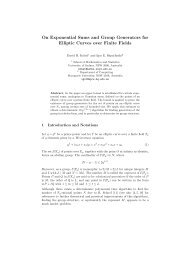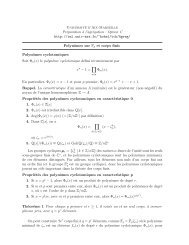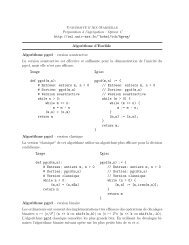Endomorphism rings of elliptic curves over finite fields by David Kohel
Endomorphism rings of elliptic curves over finite fields by David Kohel
Endomorphism rings of elliptic curves over finite fields by David Kohel
You also want an ePaper? Increase the reach of your titles
YUMPU automatically turns print PDFs into web optimized ePapers that Google loves.
CHAPTER 2. ELLIPTIC CURVES AND ISOGENIES 14x G and y G in the function field <strong>of</strong> E, invariant under G, as follows.x G (P) = x(P) +∑ (x(P + Q) − x(Q)),Q∈G−{0}y G (P) = y(P) +∑ (y(P + Q) − y(Q)).Q∈G−{0}(2.3)The functions x G and y G generate the function field for a curve E G and satisfy theconditions (2.1) <strong>of</strong> § 2.2 on E G . Then f G : E → E G defined <strong>by</strong> (x, y) ↦→ (x G , y G ),is an isogeny <strong>of</strong> Weierstrass equations. Under this isogeny <strong>of</strong> <strong>curves</strong> the invariantdifferential on the image curve E G pulls back to the invariant differential on E, thatis,fG ∗ ( dx Gdx) = ( ).2y G + a 1 x G + a 3 2y + a 1 x + a 3Following Vélu [33], we can write down explicit equations for x G and y G in terms <strong>of</strong>x and y defining the isogeny f G <strong>of</strong> <strong>curves</strong> with the kernel specified <strong>by</strong> ψ(x) in k[x].He develops rational functions in terms <strong>of</strong> the roots <strong>of</strong> ψ(x), but the isogeny is moreappropriately expressed in terms <strong>of</strong> symmetric functions in the roots as follows.Isogenies <strong>of</strong> odd degreeFirst we assume that the degree <strong>of</strong> the isogeny determined <strong>by</strong> the equation ψ(x) forthe kernel is odd. A general isogeny <strong>over</strong> k can be decomposed <strong>over</strong> k into a composite<strong>of</strong> isogenies <strong>of</strong> degree 2 or 4 and isogenies <strong>of</strong> odd degree. We will treat decomposition<strong>of</strong> G in the sequel.The isogeny is described in terms <strong>of</strong> the coefficients <strong>of</strong> ψ(x) as follows.where φ(x) is given <strong>by</strong>(x, y) ↦−→ (x G , y G ) = ( φ(x) ω(x, y)ψ(x) 2, ψ(x) ), 3φ(x) = (4x 3 + b 2 x 2 + 2b 4 x + b 6 )(ψ ′ (x) 2 − ψ ′′ (x)ψ(x))−(6x 2 + b 2 x + b 4 )ψ ′ (x)ψ(x) + (dx − 2s 1 )ψ(x) 2 ,where the degree <strong>of</strong> the isogeny is d = 2n+1, and s i is the ith elementary symmetricfunction in the roots <strong>of</strong> ψ(x), so that ψ(x) = x n − s 1 x n−1 + · · · + (−1) n s n .If the characteristic <strong>of</strong> the base field k is different from 2, one can derive the equationfor ω(x, y) from φ(x) and ψ(x) using the condition that the the invariant differentialon E G pulls back to the invariant differential on E.ω(x, y) = φ ′ (x)ψ(x)ψ 2 /2 − φ(x)ψ ′ (x)ψ 2 + (a 1 φ(x) + a 3 ψ(x) 2 ))ψ(x)/2.








